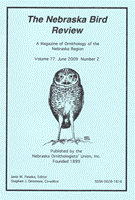Nebraska Ornithologists' Union

Nebraska Bird Review
Date of this Version
12-1981
Document Type
Article
Citation
"Book Review," from Nebraska Bird Review (December 1981) 49(4).
Abstract
Birds - Their Latin Names Explained, A.F. Gotch, 348 pp., 5½; x 8½;, Blandford Press, England, Sterling Publishing Co., Inc., New York. Hardbound, indexed, $22.50.
"The first five chapters of the book explain the system of classification started by the Swedish naturalist Carl von Linné during the eighteenth century, and which became known as the Binominal System. Chapter 6 then sets out this system with reference to the Class Aves the birds - and each of the following chapters is devoted to one of the 27 Orders of birds." In these last chapters the author gives the Order, Family, and Sub-family names and the explanation of each, and he gives about 1,850 out of the about 8,600 known species, with an explanation of the scientific names and often, but not always, of the common names. He also gives the ranges for the species listed, but is a little enthusiastic in using "North America" and includes some accidentals and peripheral (e.g., Greenland) species. This is a British book and uses their order of presentation, with crows and jays last, a problem easily solved by the index; it doesn't always give the American common name when it differs from the British; and while it includes many North American birds not found in Britain, it also leaves out many. This last makes it an incomplete reference for us as far as specific species go, but it is an interesting and informative book to read and very suitable for browsing.
-Editor
A Natural Collection, Steven C. Wilson and Karen C. Hayden, 218 pages, 6 x 9, not indexed, both hard and soft bound. An Ethnos Book, Bainbridge Island, Washington. Available from the National Audubon Society, New York, $10.00.
This is a collection of photographs, taken in 1979 along with the Texas seashore (mostly Aranas National Wildlife Refuge and Padre Island National Seashore) and two, of Sandhill Cranes, in Nebraska. The pictures are wonderful and cover landscapes, insects, plants, animals, birds (mostly birds), with a few of people and things, all in color. There are small bits of text mixed in with the pictures, but with no specific reference to the pictures. But at the back the pictures are described with the time, place, and subjects identified, and sometimes additional comments. Conoco, which has produced oil on the Refuge since 1947, underwrote the book and gave 5,000 copies to National Audubon Society, but they or their installations come up only a few times, and then as background for some natural object. Oil and its effect on the beaches is shown a few times too. When it is commented upon, the oil is from the run-away Mexican oilwell, Ixtoc 1, and this presumably is also the case where it isn't mentioned. This is an enjoyable book to look at, and if you can catch your friends before they discover the answers in the back of the book, you can amaze them with your identifications.
-Editor


Comments
Copyright 1981, Nebraska Ornithologists' Union. Used by permission.